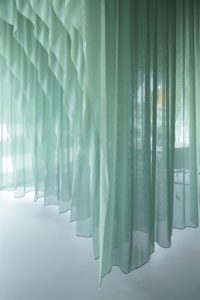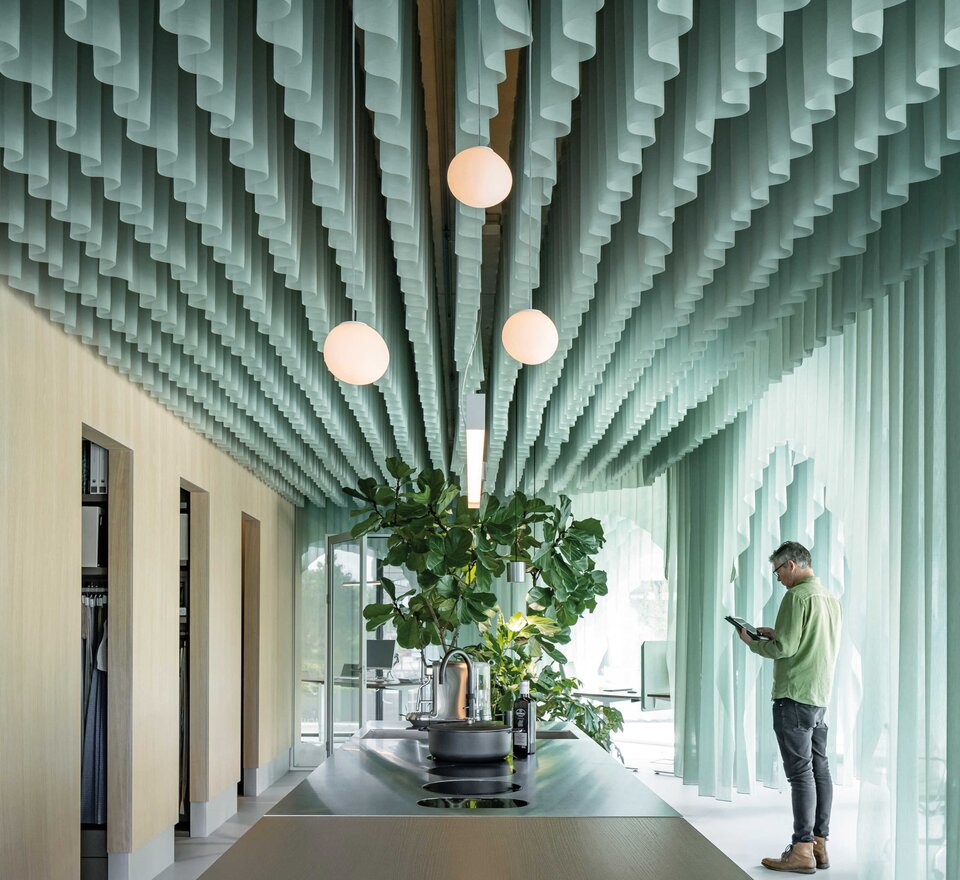For the Amsterdam interior designer Siersema, the architect’s office Beyond Space has opted for a kilometre of Kvadrat fabric and created a poetic concept made of partitions and soft portals. An ode to sky and sea.
While he was still alive around 1900, the German writer Christian Morgenstern dreamed of the dissolution of the dividing line between heaven and earth. “Clouds will perhaps be revered in a special way some day – as the only visible barrier separating human beings from infinity, as the majestic curtain before the open, fourth wall of our earthly stage.” The Dutch architect’s office Beyond Space has now reconstructed this metaphor as a tangible theatrical image, or rather, image of work. Near Entrepothaven east of Amsterdam, the office literally enveloped the local interior design studio Siersema in a new garment of sky- and ocean-blue curtain material.
“Here we are in the midst of a new urban development zone, formerly a location for storage and logistics warehouses for Dutch shipping,” says Stijn de Weerd, who runs Beyond Space together with his partner Remi Versteeg. “The area is still being developed; a rather bleak, industrial and workaday aura still dominates the surroundings. Our clients themselves deal professionally in carpets, textiles and interior decoration, so it was important for us to give the space a specific potential in atmosphere and friendly warmth.” The result of these considerations is a large open space measuring around 200 square metres in which rooms, work zones and conference areas were defined by the most delicate, the softest imaginable construction material of all time.
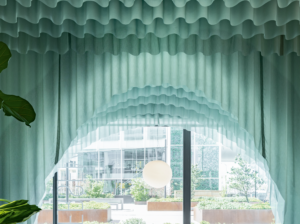
“We used about a kilometre of fabric in all; the important aspect for us was to create a specific transparency and veil-like nebulosity,” says de Weerd. The choice fell ultimately on thin, translucent, almost transparent gauze from the Danish house of Kvadrat, with the colour designation Ocean Hue. “We experimented around quite a bit with the wave density and the distance between the single lengths of material until we achieved the desired effect. After quite a few iterations, we obtained a spatial impression that was at times buoyant and light, at times clearly screened off and reclusive, without feeling at any time entirely enveloped and suffocated in material.” In some places you hardly had the feeling of standing in a new building, just finished in 2021. You are deliciously immersed – in a reinterpretation of great-aunt’s boudoir – in a cotton-wool cloud floating on an aesthetic of sky and oceanic feeling.
We used about a kilometre of fabric in all.
As regards technical aspects, the secret behind this extraordinary interior project is the use of a standard polyester material; in the contracting sector it is among the most popular products by Kvadrat and Siersema. The textile, woven of gossamer threads, meets all fire and smoke regulations, and it could be laser-cut, thanks to its dense weave. Edging it to avoid fraying or wild threads wasn’t necessary. Only a fine lead strip was sewn into the bottom edge to attain an even weight and to give it a specific inertia so that the whole construct doesn’t relapse into chaos at the slightest gust of wind. If the fabric has to be cleaned in two or three years, the lengths can be removed from the ceiling in one piece.
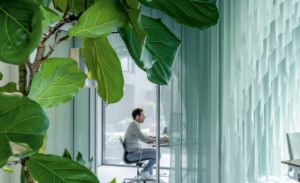
The material pot-pourri is complemented by a light-grey linoleum floor by Forbo. “Linoleum is warm, pleasantly haptic and has excellent acoustic qualities,” says de Weerd. “We have even designed home and office furniture with it.” A high bar table in the middle of the room is used simultaneously as kitchen and conference table for stand-up meetings. The table is likewise an exclusive design by Beyond Space. And then there are the potted plants; their delicate, dark-green leaves enter into a somehow flirtatious dialogue with the bright ocean waves.
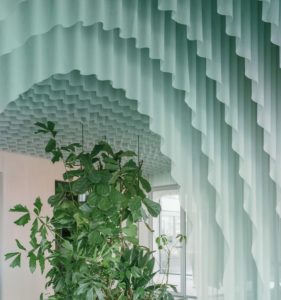
“We have often heard that the Siersema office space has a feminine aura, and we see this as a compliment, because we are after all an architecture firm with two men at the top,” says Stijn de Weerd. “It’s wonderful that we have succeeded in conveying such an image.” Beyond Space itself describes this design approach as radical cosiness. “A certain cosiness and homeliness is important in the office, because I also like to feel good when I’m at work,” says the architect. “However, an office shouldn’t be confused with a living room. The visible radicalness here is a way of “coming on strong”, playing with images and clichés.” And a form of manifesting the core competence of an interior designer with tongue in cheek and a great dash of poetry.
